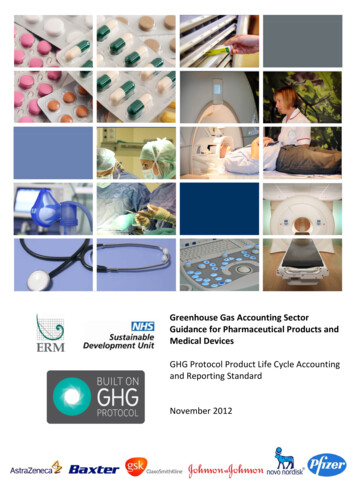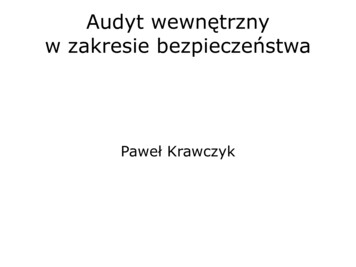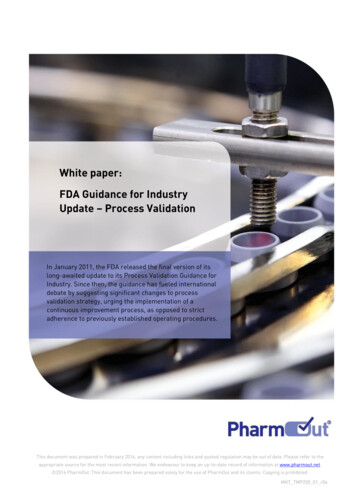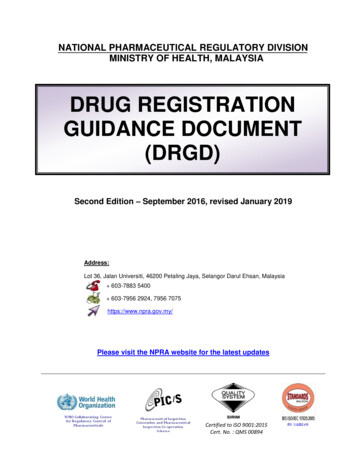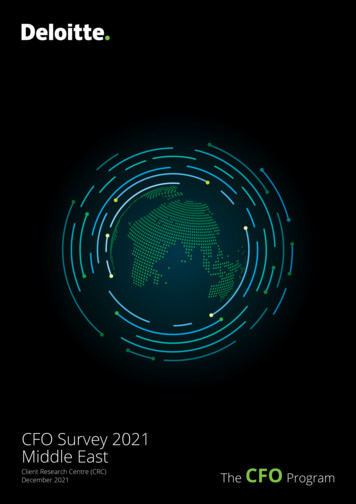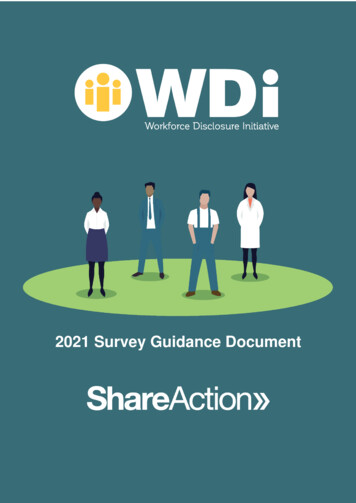
Transcription
2021 Survey Guidance Document1
Version nges madeInitial document publishedAppendix of changes to Guidance document addedAdded Core indicators to relevant question numberss2
ContentsIntroduction to the Workforce Disclosure Initiative . 4Governance of the WDI . 4This guidance document. 4The Business Case: Why Take Part? . 5WDI Survey Methodology. 7Survey structure and content . 7The reporting process and scoring . 9General advice and FAQs . 12Advancing reporting through the WDI survey . 12Question formats and answer structures . 13Sector-specific considerations and relevance . 13Section 1: Governance – Direct Operations and Supply Chain . 15Section 2: Risk assessment and human rights due diligence – Direct Operations and SupplyChain . 23Section 3: Workforce composition – Direct Operations . 39Section 4: Diversity and inclusion – Direct Operations. 49Section 5: Workforce wage levels and pay gaps – Direct Operations . 61Section 6: Stability – Direct Operations . 68Section 7: Training and development – Direct Operations . 72Section 8: Health, safety and wellbeing – Direct Operations . 79Section 9: Worker voice and representation – Direct Operations . 94Section 10: Grievance mechanisms – Direct Operations . 104Section 11: Supply chain transparency – Supply Chain. 110Section 12: Responsible sourcing – Supply Chain. 117Section 13: Supply chain working conditions – Supply Chain . 127Appendix I: Alignment references . 133Appendix II: Glossary . 133Appendix III: Survey and guidance changes . 1452021 WDI survey changes. 1452021 guidance document changes . 1483
Introduction to the Workforce Disclosure InitiativeThe Workforce Disclosure Initiative (WDI) is an investor collaborative designed to helpcompanies improve the standard of reporting on workforce metrics. It was created in responseto investor concerns that companies’ public reports do not yet provide the meaningful andcomparable information on workforce issues that investors seek.The WDI provides companies with a comprehensive online reporting platform to disclose dataon the workforce policies and practices underpinning the management of their employees andwider workforce. The WDI survey is designed to capture information that companies alreadycollect and disclose as well as new information of importance to investors.The long-term goal of the WDI is to improve the quality of jobs in the direct operations andsupply chains of listed companies around the world. As such, the WDI adopts a holistic view ofa company’s workforce, encompassing the employees and contingent workers in a company’sdirect operations as well as workers in its supply chain.As of June 2021, the WDI has 56 investor signatories with over 7.5 trillion in AUM from 10countries.Companies that disclose through the WDI will have the opportunity to show, to a significantgroup of investors, that they are prioritising workforce issues and taking their responsibilities asemployers and businesses seriously. Participation also indicates that companies aredemonstrating leadership by being prepared to work collaboratively towards the goal of greatertransparency and ultimately towards better outcomes for their business and their workers.Governance of the WDIThe WDI is coordinated by ShareAction, a registered charity with a mission to transform capitalmarkets into a force for public good. Our vision is of a responsible investment system that trulyserves savers, communities, and protects our environment for the long term. We are based inthe UK but seek to partner with international allies to effectively influence global stakeholders.The WDI is supported by charitable funding, and investor signatories contribute a fee based ontheir institution type and size.This guidance documentThis guidance document provides companies with information on how to complete the WDIsurvey. The document follows the structure of the survey and sets out why transparency in eacharea is important, followed by guidance on how to answer each question and a glossary of keywords/phrases used throughout this document and the survey. The guidance is split between‘Getting started’ and ‘Next steps’. This reflects the level of complexity of the data requestedfrom the guidance and is there to help companies structure their responses by showing whichareas to prioritise if they cannot meet all the criteria. Guidance notes are also embedded next toeach question in the WDI online reporting platform. Companies are encouraged to read theguidance alongside each question as this will help ensure they provide the correct informationin each answer.If you have any questions about completing the survey, please contact: wdi@shareaction.org.4
For company-focussed WDI resources visit: e Business Case: Why Take Part?In an increasingly competitive and challenging global labour market, the way a company treatsand manages its workforce has never been more important to the long-term success of acompany. The recent COVID-19 pandemic has only served to highlight this, with companies’workforce practices facing significant scrutiny as the devastating consequences of thepandemic on workers become clear.The workforce is frequently described as a company’s greatest asset and an important sourceof value for the company. And yet, few companies disclose sufficient information to substantiatethis claim nor how they plan on ensuring they continue to attract and retain the workforce of thefuture. If the workforce generates value for the company then, as with any other asset, it mustbe nurtured in a way that protects and maximises its ability to generate long-term value andbenefits for the business. The materiality of the workforce continues to be demonstrated by agrowing body of research. Sound management of the workforce can yield positive outcomes forthe company including increased labour productivity, workforce stability and engagement. Poorworkforce management, by contrast, can lead to operational, reputational and even litigationrisks.There has been greater public scrutiny from consumers and wider society about companies’business practices and the treatment of direct employees, third-party contractors and evenworkers in the supply chain. Indeed, companies are facing increasing regulatory requirementsto disclose non-financial information with respect to their employees and their supply chains.There are also growing calls from stock exchanges around the world for companies to improvethe consistency and depth of their corporate reporting. The ripple effect created by theintroduction of legislation on workforce reporting across the world, including in the UK,1France,2 California,3 the Netherlands,4 Spain,5 Australia,6 and Germany,7 means thatcompanies that are already scrutinising their workforce footprint and implementing the United1Modern Slavery Act 2015, accessed 26th August contents/enacted.2 French Corporate Duty of Vigilance Law 2017, accessed 26 th August rate-duty-of-vigilance-law-english-translation/.3 The California Transparency in Supply Chains Act, accessed 26 th August 2020,https://oag.ca.gov/SB657.4 Business and Human Rights Resource Centre, “Dutch Senate votes to adopt child labour duediligence law”, accessed 26th August 2020, gence-law/.5 Baker & McKenzie, “The Latest Developments in Gender Pay: France & Spain Issue NewLegislation to Tackle the Gap”, accessed 26th August pay.6 Modern Slavery Act 2018, accessed 26th August 001537 Lexology, “Who is affected by the CSR Directive Implementation Act?”, accessed 26th August2020, https://www.lexology.com/library/detail.aspx?g 743ef117-dde0-4618-9d6f-e21a696639405
Nations Guiding Principles on Business and Human Rights (UNGPs) are well positioned toanticipate future regulatory developments. To read more about this and the business case forcorporate transparency and improving workforce management and engagement, read our “NewFrontier” report here on the website.At the global level, investors and companies play a critical role in the delivery of the SustainableDevelopment Goals (SDGs) and the Paris Agreement, global roadmaps for addressing theprevailing crises of inequality and climate change, both of which pose significant risks toworkers, business and their shareholders. Increasing transparency and reporting on theworkforce is a prerequisite for understanding how companies are helping to both deliver thegoals of Decent Work while also ensuring that the transition to a low carbon economy is bothjust and socially inclusive, with proper consideration to the impacts on workers and recognitionof their role in directly delivering the transition.This drive to promote corporate transparency is an opportunity for companies to harness thedata to improve practices, and to draw on the insights from the data they collect to differentiatethemselves from peers. Leading companies recognise the value of improving workforcemanagement and are starting to map and monitor their global workforce as part of theirbusiness strategy, using the WDI as a tool. This is allowing them to instigate new conversationsand improve existing structures and processes within the company.Information captured through the WDI responses is designed to help investors understand acompany’s approach to its workforce, its employment and supply chain practices, and theextent to which it is managing related risks and opportunities. The WDI has helped sparkconversations between investors and companies about the company’s workforce, theprocesses in place to identify and manage workforce risks and opportunities, and the need forbetter quality data on how the company is ensuring improved outcomes for both workers andbusiness.6
WDI Survey MethodologySurvey structure and contentThe WDI survey has been revised and refined in order to meet the needs of investor signatoriesand elicit the most meaningful workforce data from globally listed companies. The WDI followsan iterative process each year to ensure the survey provides a robust and comprehensiveframework for assessing companies on their workforce management, and that it reflects arapidly evolving corporate reporting landscape which brings about complex reporting challengesfor companies. We are grateful to all stakeholders who have contributed time and constructivefeedback to the process since the first survey was sent out during our pilot year in 2017.Survey structure and changes for 2021The WDI survey comprises 13 sections:Section12345678910111213Subject of sectionGovernanceRisk assessment and human rights due diligenceWorkforce compositionDiversity and inclusionWorkforce wage levels and pay gapsStabilityTraining and developmentHealth, safety and wellbeingWorker voice and representationGrievance mechanismsSupply chain transparencyResponsible sourcingSupply chain working conditionsPart of businessDirect Operations and Supply ChainDirect Operations and Supply ChainDirect OperationsDirect OperationsDirect OperationsDirect OperationsDirect OperationsDirect OperationsDirect OperationsDirect OperationsSupply ChainSupply ChainSupply ChainQuestions in the WDI have been designed to be relevant to all business models and sectors.This year, questions looking at human rights policies and governance of workforce issues havebeen streamlined to reduce the reporting burden on companies.New questions have been added on child labour (question 2.10), prison labour (question 2.11),workforce surveillance (question 2.12) and additional diversity data monitoring (question 4.10).A summary of all the changes made to the 2021 WDI survey and guidance document can befound in Appendix III.Question tiersThe WDI can be a time and resource intensive process for those at the very start of theirreporting journey where the systems and processes for collecting and reporting data have notyet been established. In recognition of this, the WDI introduced question tiers (formerlyDisclosure levels) to help companies new to this area of reporting prioritise their reportingefforts. A summary of these tiers is provided below. Companies are encouraged to prioritiseFoundation tier questions in their first years of reporting to the WDI, gradually working up toIntermediate and ultimately Comprehensive tiers. While many companies may find that they7
have data to report and gaps to fill across all levels, the question tiers are a useful lens for thosecompanies in need of a more structured approach in the early days of workforce reporting.Foundation: questions that ask for information on the governance of the workforce, policycommitments and risk assessment processes across the workforce; basic human capitalmetrics in the direct operations such as the number of employees and turnover rates; andsimple information on the structure and composition of the first tier supply chain and thecompany’s sourcing and purchasing practices. Foundation questions make up about 55% of thesurvey.Intermediate: questions that go beyond commonly reported metrics to provide additionalinsights into the risks and opportunities in the direct operations such as pay ratios and theeffectiveness of remedial actions. In the supply chain, questions ask for information on the sizeand location of the first-tier workforce and the risks to workers’ rights. Intermediate questionsmake up about 35% of the survey.Comprehensive: questions that reflect the challenges of collecting and reporting information onaspects which are often overlooked such as detailed demographic breakdowns of the workforceand the outcomes of worker representation; and in the supply chain, more detailed informationon its composition. Comprehensive questions make up about 10% of the survey.Core indicatorsIn 2021, the WDI has introduced core indicators. These are a small set of WDI indicators whichcapture the fundamental data companies need to be able to understand and improve theconditions of their workforce. These indicators have been introduced to provide respondingcompanies with an additional framework to consider when considering which parts of the surveyto prioritise.Core indicators are not the most rudimentary or basic information a company should report ontheir workforce. Instead, they are indicators that provide data that, when not collected,significantly hampers a company’s ability to meaningfully improve working conditions and/ordata that is indicative of a company’s broader approach to managing its workforce.Public answers vs answers for WDI signatory investors onlyFor the majority of the survey, companies can choose to make each answer public or availableonly to WDI signatory investors. If public, the answers are viewable via the WDI website to allwho wish to view them (the 2020 public data is downloadable from scribe/1). Otherwise, companies can make theiranswers available only to the WDI signatory investors, but the data will be used in aggregateanalysis.Our signatory investors encourage companies to make as much of their response public aspossible and in an effort to promote this, there are a handful of questions in the survey whoseanswers are mandatorily public. These are mostly Foundation tier questions and are shown inthis document in the “Privacy setting of answer” columns below as well as in the onlinereporting platform and the Excel version of the survey which can be found here.To understand more about how your data will be used after it has been submitted, please readthe “submission agreement”.8
Scope of disclosure and additional contextual information about your responseWhen companies report workforce data, it is not always clear which aspects of the business thedata relates to. As such, in an effort to continuously improve the comparability of the datacompanies report, the WDI is evolving its approach to understand the ‘scope’ or boundary forreporting.At the end of every topic, there is a free text box for “Notes on this topic” which the companycan use to add any extra contextual information for their answers in that topic. This informationis not scored.In 2021, companies are asked to set out their significant operating locations, that is, countries orregions which are of significance to the company because of, for example, the level of spend,the number of employees and/or the criticality of the location to business continuity. Theseoptions refer to questions on employee breakdown, collective bargaining agreement coverageand occupational health and safety. Given the complexity of providing a clear reportingboundary, companies will still be able to explain or clarify criteria they have used to determinewhat constitutes a significant operating location for them.Alignment with other frameworksThe workforce reporting landscape is complex. However, across different frameworks there aremany important convergence points that help bring greater transparency to a long-neglectedaspect of corporate business. The WDI reflects the existing universe of workforce indicators andorganisations by referencing them throughout the WDI survey where there is obvious overlap inthe data being requested. This cross-referencing shows how different reporting requestsintegrate with each other and alerts companies to data points they may have reportedelsewhere. A list of frameworks referenced in the survey is included in Appendix I on page 133.WDI survey consulteesNumerous stakeholders, each with specific expertise and insight, have provided critique andcomment on the WDI survey since its conception in 2016. These include: participating and nonparticipating companies, investor signatories, civil society, reporting frameworks and standards,trade unions, social auditors, academics and a mixed group of external topic experts in areassuch as gender equality, human resources, and responsible sourcing. In 2021, we areespecially grateful to the numerous individuals and organisations who provided insight andexpertise in support of the project. The comments provide an ongoing source of learning anddebate, feeding into the ongoing evolution of the project.The reporting process and scoringCompanies must submit their answers online through the WDI online reporting platform. Anycompanies not already in receipt of a web link to access the platform should contact the WDIteam to request one: wdi@shareaction.org. An Excel version of the survey can be used to draftanswers and is downloadable from here.Companies have until Friday 29 October 2021 to submit their response via the onlinereporting platform.The WDI team is available throughout the reporting period to support companies individually or9
via group webinars. Companies are encouraged to contact the team as early as possible overthe reporting period. We recognise that companies are at different stages of workforce datacollection and reporting and that establishing new data collection systems takes time. We inviteall companies to be open about gaps in their current data, and the challenges in collecting andreporting the requested information. We also encourage companies to provide feedback on thereporting process which is crucial to helping develop a more robust survey for future years.There is a glossary at the end of this document to provide clarification on words and phrases.All the information disclosed via the WDI will be made available to the WDI investor signatories.Investors will be able to use this information to inform their direct engagements with companiesand to integrate into their financial assessments of companies. The WDI will also makeavailable to investors the reasons companies give for not taking part in the Initiative.After the disclosing period ends, companies will receive a Disclosure Score and a DisclosureScorecard – only viewable to your company, the WDI signatories and WDI partners – whichevaluate a response based on the level of completeness and provide a basic benchmark topeer groups of responding companies. A dummy version of the Disclosure Scorecard can beviewed here.The WDI team will facilitate dialogue between investors and companies on the responsessubmitted and topics covered in the survey and we encourage all companies to come to all thewebinars and events we hold; please check this page regularly for upcoming es/webinars/.In early 2022, the WDI team will publish a public report on the results of the responses in 2021,with an emphasis on the progress being made in workforce reporting and transparency, sharingexamples of good practice from disclosing companies and providing guidance on ways tofurther improve workforce reporting. This report will contain a list of all responding companiesand you can see the 2020 version here: initiative-2020-findings/Scoring methodologyAs mentioned above, each company’s response is given a Disclosure Score which aims toassess its completeness (i.e., the amount of data the company provided). It is not an evaluationof the quality of the company’s answers or its workforce policies and practices. The scoring ruleapplied to each question is shown in the detailed guidance below; there are ten possible rules:Rule 1 free text box or simple drop-down menuRule 2 answer to a yes/no follow up questionRule 3 yes/no parent question where the 'yes' selection scores 1 point, and the answer toboth the 'yes' and 'no' follow up questions score 1 pointRule 4 table where 1 point is awarded for every editable cellRule 5 table where only the first cell is scoredRule 6 table where column 2 of the top 2 rows is scored (except for Q11.4 where column 2of the top 5 rows are scored)Rule 7 table where points are awarded for data in either column 2 or 3, up to a maximumnumber of points with each row capped at 1 point10
Rule 8 table where points are awarded for data in either column 2, 3 or 4, up to a maximumnumber of points with each row capped at 1 pointRule 9 table where points are awarded for data in column 2 and then in either column 3, 4or 5, up to a maximum number of points where each row is capped at 1 point fromcolumn 3 onwardsWorkforce Transparency AwardsIn 2020, the WDI introduced the “Workforce Transparency Awards” which recognise thecompanies for the level of information they submit. Companies that win awards will berecognised at the WDI Awards Ceremony following the publication of the survey findings andwill be profiled on the WDI website and in communications. Companies that win awards (notspecial mentions) will also receive a physical award to demonstrate their leadership inworkforce transparency.Award categories, and the criteria for each award, are as follows:AwardThe WDI AwardBest First-time ResponderMost ImprovedSupply Chain DataMost Transparent (specialmention)Contingent Workforce DataWorkforce Action (specialmention)COVID-19 Transparency (specialmention)CriteriaThe company/ies with the most complete responseThe company/ies taking part for the first time whocompleted the highest proportion of the surveyThe company/ies with the largest increase in thecompleteness of its/their responseThe company/ies with the most data covering theirsupply chain (i.e., most complete response acrossSections 11-13)The companies that opt to make their response 100%publicThe company/ies with the most data for workers onnon-permanent contracts (i.e., most complete responseacross questions 3.3, 3.4, 3.5, 3.6, 3.8, 5.9, 6.2, 7.6,8.5, 8.6, 9.5)The companies that answered the highest number ofquestions looking at how companies are implementingworkforce practices (questions 2.8, 2.9, 2.13, 4.1, 4.6,5.4, 5.9, 8.14, 9.6a/9.6b, 9.9, 10.5, 13.1, 13.2, 13.5)The companies that answered the most questions onCOVID-19 (questions 2.13, 8.12, 8.13, 8.14)The 2020 award winners can be viewed at: initiative-2020-findings/#2020-awardwinners11
General advice and FAQsThe list below includes some of the most common questions from companies when respondingto the WDI survey.Advancing reporting through the WDI surveyI am just getting started with the survey, are there any areas that I should prioritise?The WDI survey and question guidance is structured in a way to support companies to prioritisetheir responses and progressively increase the level of workforce data they report as theybecome more accustomed to responding to the survey. There are three main ways companiescan prioritise their response.Companies should focus on providing data for the Foundation tier questions, which ask for themost basic and commonly reported workforce metrics. Companies should also aim to respondto as many of the Core Indicators as possible, as these ask companies for the data that can bemost insightful when looking to improve workforce practices. Lastly, the guidance for eachquestion has been structured to highlight what data can be reported when a company is ‘gettingstarted’ and what would be the more detailed data companies provide as ‘next steps’. Even ifthe company cannot meet every criteria in the guidance, providing data on just the ‘gettingstarted’ components can help prioritise data collection and responses and establish afoundation for more detailed data in future years.My organisation has been taking part for a couple of years, how can we improve our WDIresponse?Organisations that are looking to advance their workforce reporting should aim to complete asmany Intermediate tier questions as possible. Companies should also aim to report against allCore Indicators.Companies should also aim to provide more comprehensive data for the questions they arealready responding to, for example, by providing data that covers more operating locations anda larger proportion of the workforce. They should be meeting all ‘getting started’ criteria in theguidance for every data point they provide, as well as aiming to provide data for more ‘nextsteps’ criteria. Organisations should also consider how they can provide more data on topicsthat are traditionally underreported, such as workforce stability.How can my organisation become a leading WDI responder?Companies that are looking to establish themselves as leaders in workforce reporting should beaiming to provide data for as many Comprehensive tier indicators as possible. These arequestions that reflect the challenges of collecting and reporting information on aspects whichare often overlooked. Leading companies should already be providing detailed data against allCore Indicators and, wherever possible, providing data that covers as large a proportion of thecompanies’ operations as possible. Leading companies should also be meeting the majority ofall guidance criteria (both ‘getting started’ and ‘next steps’) for each question.12
Question formats and answer structuresThe question is asking for an example of something that my company has never done,how should I respond?Example question: 2.9 Provide an example of how the company has monitored theeffectiveness of actions taken to address negative impacts on the human rights of workers inthe reporting period, including by consulting with impacted workers and any lessons learned.Reco
The WDI provides companies with a comprehensive online reporting platform to disclose data on the workforce policies and practices underpinning the management of their employees and wider workforce. The WDI survey is designed to capture information that companies already collect and disclose as well as new information of importance to investors.



